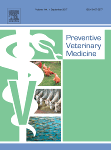Ver ítem
- xmlui.general.dspace_homeCentros Regionales y EEAsCentro Regional Santa FeEEA RafaelaArtículos científicosxmlui.ArtifactBrowser.ItemViewer.trail
- Inicio
- Centros Regionales y EEAs
- Centro Regional Santa Fe
- EEA Rafaela
- Artículos científicos
- Ver ítem
Risk factors for the presence of Deformed wing virus and Acute bee paralysis virus under temperate and subtropical climate in Argentinian bee colonies
Resumen
Beekeepers all across the world are suffering important losses of their colonies, and the parasitic mites Varroa destructor and Nosema sp, as well as several bee viruses, are being pointed out as the possible causes of these losses, generally associated with environmental and management factors. The objective of the present study was to evaluate the presence of seven virus species (Deformed wing virus –DWV-, Acute bee paralysis virus –ABPV-, Chronic bee
[ver mas...]
Beekeepers all across the world are suffering important losses of their colonies, and the parasitic mites Varroa destructor and Nosema sp, as well as several bee viruses, are being pointed out as the possible causes of these losses, generally associated with environmental and management factors. The objective of the present study was to evaluate the presence of seven virus species (Deformed wing virus –DWV-, Acute bee paralysis virus –ABPV-, Chronic bee paralysis virus –CBPV-, Black queen cell virus –BQCV-, Kashmir bee virus –KBV-, Israeli acute bee paralysis virus –IAPV-, and Sacbrood bee virus –SBV), as well as the prevalence of Nosema sp. and Varroa destructor, and their possible associated factors, under temperate and subtropical climate conditions in Argentinean colonies. A total of 385 colonies distributed in five Argentinean eco-regions were examined after honey harvest. The final multivariable model revealed only one variable associated with the presence of DWV and two with the presence of ABPV. The apiary random effect was significant in both cases (P = 0.018; P = 0.006, respectively). Colonies with a Varroa infestation rate >3% showed higher presence of DWV than colonies with <3% of Varroa infestation level (OR = 1.91; 95% CI: 1.02–3.57; P < 0.044). The same pattern was observed for the presence of ABPV (OR = 2.23; 95% CI: 1.04–4.77; P < 0.039). Also, colonies where replacement of old combs was not a common practice had higher presence of ABPV (OR = 6.02; 95% CI: 1.16–31.25; P < 0.033). Regardless of the location of the colonies, virus presence was strongly associated with V. destructor level. Therefore, all the factors that directly or indirectly influence the levels of mites will be also influencing the presence of the viruses.
[Cerrar]

Fuente
Preventive Veterinary Medicine 140 : 106-115
Fecha
2017-05
ISSN
0167-5877
Formato
pdf
Tipo de documento
artículo
Palabras Claves
Derechos de acceso
Restringido
 Excepto donde se diga explicitamente, este item se publica bajo la siguiente descripción: Creative Commons Attribution-NonCommercial-ShareAlike 2.5 Unported (CC BY-NC-SA 2.5)
Excepto donde se diga explicitamente, este item se publica bajo la siguiente descripción: Creative Commons Attribution-NonCommercial-ShareAlike 2.5 Unported (CC BY-NC-SA 2.5)

